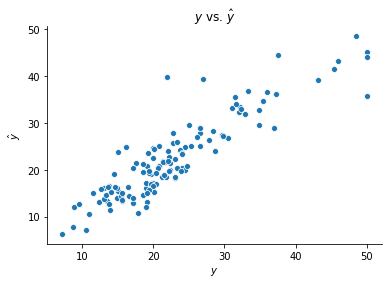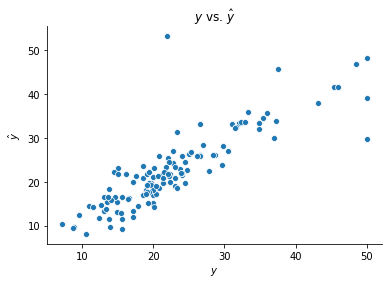Construction¶
In this section, we construct two classes to implement a basic feed-forward neural network. For simplicity, both are limited to one hidden layer, though the number of neurons in the input, hidden, and output layers is flexible. The two differ in how they combine results across observations. The first loops through observations and adds the individual gradients while the second calculates the entire gradient across observatinos in one fell swoop.
Let’s start by importing numpy, some visualization packages, and two datasets: the Boston housing and breast cancer datasets from scikit-learn. We will use the former for regression and the latter for classification. We also split each dataset into a train and test set. This is done with the hidden code cell below
## Import numpy and visualization packages
import numpy as np
import matplotlib.pyplot as plt
import seaborn as sns
from sklearn import datasets
## Import Boston and standardize
np.random.seed(123)
boston = datasets.load_boston()
X_boston = boston['data']
X_boston = (X_boston - X_boston.mean(0))/(X_boston.std(0))
y_boston = boston['target']
## Train-test split
np.random.seed(123)
test_frac = 0.25
test_size = int(len(y_boston)*test_frac)
test_idxs = np.random.choice(np.arange(len(y_boston)), test_size, replace = False)
X_boston_train = np.delete(X_boston, test_idxs, 0)
y_boston_train = np.delete(y_boston, test_idxs, 0)
X_boston_test = X_boston[test_idxs]
y_boston_test = y_boston[test_idxs]
## Import cancer and standardize
np.random.seed(123)
cancer = datasets.load_breast_cancer()
X_cancer = cancer['data']
X_cancer = (X_cancer - X_cancer.mean(0))/(X_cancer.std(0))
y_cancer = 1*(cancer['target'] == 1)
## Train-test split
np.random.seed(123)
test_frac = 0.25
test_size = int(len(y_cancer)*test_frac)
test_idxs = np.random.choice(np.arange(len(y_cancer)), test_size, replace = False)
X_cancer_train = np.delete(X_cancer, test_idxs, 0)
y_cancer_train = np.delete(y_cancer, test_idxs, 0)
X_cancer_test = X_cancer[test_idxs]
y_cancer_test = y_cancer[test_idxs]
Before constructing classes for our network, let’s build our activation functions. Below we implement the ReLU function, sigmoid function, and the linear function (which simply returns its input). Let’s also combine these functions into a dictionary so we can identify them with a string argument.
## Activation Functions
def ReLU(h):
return np.maximum(h, 0)
def sigmoid(h):
return 1/(1 + np.exp(-h))
def linear(h):
return h
activation_function_dict = {'ReLU':ReLU, 'sigmoid':sigmoid, 'linear':linear}
1. The Loop Approach¶
Next, we construct a class for fitting feed-forward networks by looping through observations. This class conducts gradient descent by calculating the gradients based on one observation at a time, looping through all observations, and summing the gradients before adjusting the weights.
Once instantiated, we fit a network with the fit() method. This method requires training data, the number of nodes for the hidden layer, an activation function for the first and second layers’ outputs, a loss function, and some parameters for gradient descent. After storing those values, the method randomly instantiates the network’s weights: W1, c1, W2, and c2. It then passes the data through this network to instantiate the output values: h1, z1, h2, and yhat (equivalent to z2).
We then begin conducting gradient descent. Within each iteration of the gradient descent process, we also iterate through the observations. For each observation, we calculate the derivative of the loss for that observation with respect to the network’s weights. We then sum these individual derivatives and adjust the weights accordingly, as is typical in gradient descent. The derivatives we calculate are covered in the concept section.
Once the network is fit, we can form predictions with the predict() method. This simply consists of running test observations through the network and returning their outputs.
class FeedForwardNeuralNetwork:
def fit(self, X, y, n_hidden, f1 = 'ReLU', f2 = 'linear', loss = 'RSS', lr = 1e-5, n_iter = 1e3, seed = None):
## Store Information
self.X = X
self.y = y.reshape(len(y), -1)
self.N = len(X)
self.D_X = self.X.shape[1]
self.D_y = self.y.shape[1]
self.D_h = n_hidden
self.f1, self.f2 = f1, f2
self.loss = loss
self.lr = lr
self.n_iter = int(n_iter)
self.seed = seed
## Instantiate Weights
np.random.seed(self.seed)
self.W1 = np.random.randn(self.D_h, self.D_X)/5
self.c1 = np.random.randn(self.D_h, 1)/5
self.W2 = np.random.randn(self.D_y, self.D_h)/5
self.c2 = np.random.randn(self.D_y, 1)/5
## Instantiate Outputs
self.h1 = np.dot(self.W1, self.X.T) + self.c1
self.z1 = activation_function_dict[f1](self.h1)
self.h2 = np.dot(self.W2, self.z1) + self.c2
self.yhat = activation_function_dict[f2](self.h2)
## Fit Weights
for iteration in range(self.n_iter):
dL_dW2 = 0
dL_dc2 = 0
dL_dW1 = 0
dL_dc1 = 0
for n in range(self.N):
# dL_dyhat
if loss == 'RSS':
dL_dyhat = -2*(self.y[n] - self.yhat[:,n]).T # (1, D_y)
elif loss == 'log':
dL_dyhat = (-(self.y[n]/self.yhat[:,n]) + (1-self.y[n])/(1-self.yhat[:,n])).T # (1, D_y)
## LAYER 2 ##
# dyhat_dh2
if f2 == 'linear':
dyhat_dh2 = np.eye(self.D_y) # (D_y, D_y)
elif f2 == 'sigmoid':
dyhat_dh2 = np.diag(sigmoid(self.h2[:,n])*(1-sigmoid(self.h2[:,n]))) # (D_y, D_y)
# dh2_dc2
dh2_dc2 = np.eye(self.D_y) # (D_y, D_y)
# dh2_dW2
dh2_dW2 = np.zeros((self.D_y, self.D_y, self.D_h)) # (D_y, (D_y, D_h))
for i in range(self.D_y):
dh2_dW2[i] = self.z1[:,n]
# dh2_dz1
dh2_dz1 = self.W2 # (D_y, D_h)
## LAYER 1 ##
# dz1_dh1
if f1 == 'ReLU':
dz1_dh1 = 1*np.diag(self.h1[:,n] > 0) # (D_h, D_h)
elif f1 == 'linear':
dz1_dh1 = np.eye(self.D_h) # (D_h, D_h)
# dh1_dc1
dh1_dc1 = np.eye(self.D_h) # (D_h, D_h)
# dh1_dW1
dh1_dW1 = np.zeros((self.D_h, self.D_h, self.D_X)) # (D_h, (D_h, D_X))
for i in range(self.D_h):
dh1_dW1[i] = self.X[n]
## DERIVATIVES W.R.T. LOSS ##
dL_dh2 = dL_dyhat @ dyhat_dh2
dL_dW2 += dL_dh2 @ dh2_dW2
dL_dc2 += dL_dh2 @ dh2_dc2
dL_dh1 = dL_dh2 @ dh2_dz1 @ dz1_dh1
dL_dW1 += dL_dh1 @ dh1_dW1
dL_dc1 += dL_dh1 @ dh1_dc1
## Update Weights
self.W1 -= self.lr * dL_dW1
self.c1 -= self.lr * dL_dc1.reshape(-1, 1)
self.W2 -= self.lr * dL_dW2
self.c2 -= self.lr * dL_dc2.reshape(-1, 1)
## Update Outputs
self.h1 = np.dot(self.W1, self.X.T) + self.c1
self.z1 = activation_function_dict[f1](self.h1)
self.h2 = np.dot(self.W2, self.z1) + self.c2
self.yhat = activation_function_dict[f2](self.h2)
def predict(self, X_test):
self.h1 = np.dot(self.W1, X_test.T) + self.c1
self.z1 = activation_function_dict[self.f1](self.h1)
self.h2 = np.dot(self.W2, self.z1) + self.c2
self.yhat = activation_function_dict[self.f2](self.h2)
return self.yhat
Let’s try building a network with this class using the boston housing data. This network contains 8 neurons in its hidden layer and uses the ReLU and linear activation functions after the first and second layers, respectively.
ffnn = FeedForwardNeuralNetwork()
ffnn.fit(X_boston_train, y_boston_train, n_hidden = 8)
y_boston_test_hat = ffnn.predict(X_boston_test)
fig, ax = plt.subplots()
sns.scatterplot(y_boston_test, y_boston_test_hat[0])
ax.set(xlabel = r'$y$', ylabel = r'$\hat{y}$', title = r'$y$ vs. $\hat{y}$')
sns.despine()

We can also build a network for binary classification. The model below attempts to predict whether an individual’s cancer is malignant or benign. We use the log loss, the sigmoid activation function after the second layer, and the ReLU function after the first.
ffnn = FeedForwardNeuralNetwork()
ffnn.fit(X_cancer_train, y_cancer_train, n_hidden = 8,
loss = 'log', f2 = 'sigmoid', seed = 123, lr = 1e-4)
y_cancer_test_hat = ffnn.predict(X_cancer_test)
np.mean(y_cancer_test_hat.round() == y_cancer_test)
0.9929577464788732
2. The Matrix Approach¶
Below is a second class for fitting neural networks that runs much faster by simultaneously calculating the gradients across observations. The math behind these calculations is outlined in the concept section. This class’s fitting algorithm is identical to that of the one above with one big exception: we don’t have to iterate over observations.
Most of the following gradient calculations are straightforward. A few require a tensor dot product, which is easily done using numpy. Consider the following gradient:
In words, \(\partial\mathcal{L}/\partial \mathbf{W}^{(L)}\) is a matrix whose \((i, j)^\text{th}\) entry equals the sum across the \(i^\text{th}\) row of \(\nabla \mathbf{H}^{(L)}\) multiplied element-wise with the \(j^\text{th}\) row of \(\mathbf{Z}^{(L-1)}\).
This calculation can be accomplished with np.tensordot(A, B, (1,1)), where A is \(\nabla \mathbf{H}^{(L)}\) and B is \(\mathbf{Z}^{(L-1)}\). np.tensordot() sums the element-wise product of the entries in A and the entries in B along a specified index. Here we specify the index with (1,1), saying we want to sum across the columns for each.
Similarly, we will use the following gradient:
Letting C represent \(\mathbf{W}^{(L)}\), we can calculate this gradient in numpy with np.tensordot(C, A, (0,0)).
class FeedForwardNeuralNetwork:
def fit(self, X, Y, n_hidden, f1 = 'ReLU', f2 = 'linear', loss = 'RSS', lr = 1e-5, n_iter = 5e3, seed = None):
## Store Information
self.X = X
self.Y = Y.reshape(len(Y), -1)
self.N = len(X)
self.D_X = self.X.shape[1]
self.D_Y = self.Y.shape[1]
self.Xt = self.X.T
self.Yt = self.Y.T
self.D_h = n_hidden
self.f1, self.f2 = f1, f2
self.loss = loss
self.lr = lr
self.n_iter = int(n_iter)
self.seed = seed
## Instantiate Weights
np.random.seed(self.seed)
self.W1 = np.random.randn(self.D_h, self.D_X)/5
self.c1 = np.random.randn(self.D_h, 1)/5
self.W2 = np.random.randn(self.D_Y, self.D_h)/5
self.c2 = np.random.randn(self.D_Y, 1)/5
## Instantiate Outputs
self.H1 = (self.W1 @ self.Xt) + self.c1
self.Z1 = activation_function_dict[self.f1](self.H1)
self.H2 = (self.W2 @ self.Z1) + self.c2
self.Yhatt = activation_function_dict[self.f2](self.H2)
## Fit Weights
for iteration in range(self.n_iter):
# Yhat #
if self.loss == 'RSS':
self.dL_dYhatt = -(self.Yt - self.Yhatt) # (D_Y x N)
elif self.loss == 'log':
self.dL_dYhatt = (-(self.Yt/self.Yhatt) + (1-self.Yt)/(1-self.Yhatt)) # (D_y x N)
# H2 #
if self.f2 == 'linear':
self.dYhatt_dH2 = np.ones((self.D_Y, self.N))
elif self.f2 == 'sigmoid':
self.dYhatt_dH2 = sigmoid(self.H2) * (1- sigmoid(self.H2))
self.dL_dH2 = self.dL_dYhatt * self.dYhatt_dH2 # (D_Y x N)
# c2 #
self.dL_dc2 = np.sum(self.dL_dH2, 1) # (D_y)
# W2 #
self.dL_dW2 = np.tensordot(self.dL_dH2, self.Z1, (1,1)) # (D_Y x D_h)
# Z1 #
self.dL_dZ1 = np.tensordot(self.W2, self.dL_dH2, (0, 0)) # (D_h x N)
# H1 #
if self.f1 == 'ReLU':
self.dL_dH1 = self.dL_dZ1 * np.maximum(self.H1, 0) # (D_h x N)
elif self.f1 == 'linear':
self.dL_dH1 = self.dL_dZ1 # (D_h x N)
# c1 #
self.dL_dc1 = np.sum(self.dL_dH1, 1) # (D_h)
# W1 #
self.dL_dW1 = np.tensordot(self.dL_dH1, self.Xt, (1,1)) # (D_h, D_X)
## Update Weights
self.W1 -= self.lr * self.dL_dW1
self.c1 -= self.lr * self.dL_dc1.reshape(-1, 1)
self.W2 -= self.lr * self.dL_dW2
self.c2 -= self.lr * self.dL_dc2.reshape(-1, 1)
## Update Outputs
self.H1 = (self.W1 @ self.Xt) + self.c1
self.Z1 = activation_function_dict[self.f1](self.H1)
self.H2 = (self.W2 @ self.Z1) + self.c2
self.Yhatt = activation_function_dict[self.f2](self.H2)
def predict(self, X_test):
X_testt = X_test.T
self.h1 = (self.W1 @ X_testt) + self.c1
self.z1 = activation_function_dict[self.f1](self.h1)
self.h2 = (self.W2 @ self.z1) + self.c2
self.Yhatt = activation_function_dict[self.f2](self.h2)
return self.Yhatt
We fit networks of this class in the same way as before. Examples of regression with the boston housing data and classification with the breast_cancer data are shown below.
ffnn = FeedForwardNeuralNetwork()
ffnn.fit(X_boston_train, y_boston_train, n_hidden = 8)
y_boston_test_hat = ffnn.predict(X_boston_test)
fig, ax = plt.subplots()
sns.scatterplot(y_boston_test, y_boston_test_hat[0])
ax.set(xlabel = r'$y$', ylabel = r'$\hat{y}$', title = r'$y$ vs. $\hat{y}$')
sns.despine()

ffnn = FeedForwardNeuralNetwork()
ffnn.fit(X_cancer_train, y_cancer_train, n_hidden = 8,
loss = 'log', f2 = 'sigmoid', seed = 123, lr = 1e-4)
y_cancer_test_hat = ffnn.predict(X_cancer_test)
np.mean(y_cancer_test_hat.round() == y_cancer_test)
0.9929577464788732
